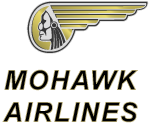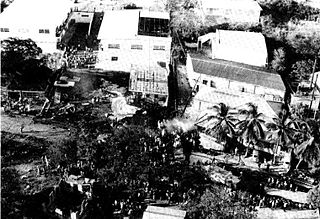
Newark Liberty International Airport is an international airport straddling the boundary between the cities of Newark in Essex County and Elizabeth in Union County, New Jersey, in the United States. Located about 4.5 miles (7.2 km) south of downtown Newark and 9 miles (14 km) west-southwest of Manhattan in New York City, it is a major gateway to points in Europe, South America, Asia, and Oceania. It is jointly owned by the cities and leased to its operator, the Port Authority of New York and New Jersey. It is the second-busiest airport in the New York airport system behind John F. Kennedy International Airport but far ahead of LaGuardia Airport.
This is a list of aviation-related events from 1952:

Allegheny Airlines was a local service carrier that operated out of Pittsburgh, Pennsylvania, from 1952 to 1979, with routes primarily located in the eastern U.S. It was the forerunner of USAir that was subsequently renamed US Airways, which itself merged with American Airlines. Its headquarters were at Washington National Airport in Arlington County, Virginia.

Mohawk Airlines was a local service carrier operating in the Mid-Atlantic region of the United States, mainly in New York and Pennsylvania, from the mid-1940s until its acquisition by Allegheny Airlines in 1972. At its height, it employed over 2,200 personnel and pioneered several aspects of regional airline operations, including being the first airline in the United States to hire an African American flight attendant, in 1958. The airline was based at Ithaca Municipal Airport near Ithaca, New York, until 1958, when it moved to Oneida County Airport in Whitestown, New York.

Capital Airlines was a United States trunk carrier, a scheduled airline serving the eastern, southern, southeastern, and midwestern United States. Capital's headquarters were located at Washington National Airport across the Potomac river from Washington, D.C., where crew training and aircraft overhauls were also accomplished. In the 1950s Capital was the fifth largest United States domestic carrier by passenger count after the Big Four air carriers.

American Airlines Flight 625, a Boeing 727-100, crashed at St. Thomas, U.S. Virgin Islands on April 27, 1976, while on a domestic scheduled passenger flight originating at T. F. Green Airport in Rhode Island and ending at Saint Thomas, United States Virgin Islands, with an intermediate stop at John F. Kennedy International Airport. 37 out of the 88 passengers on board died in the accident.

Northeast Airlines was an American trunk carrier, a scheduled airline based in Boston, Massachusetts that chiefly operated in the northeastern United States, and later to Canada, Florida, the Bahamas, Los Angeles and other cities. It was acquired by and merged into Delta Air Lines in August 1972.

Mohawk Airlines Flight 112 was a scheduled passenger flight from Rochester-Monroe Airport in Rochester, New York to Newark International Airport in Newark, New Jersey. On July 2, 1963, the aircraft operating the flight, a Martin 4-0-4 with a total of 15,970 operational hours, crashed during takeoff. The accident killed 7 people and injured 36.

North Central Airlines was a local service carrier, a scheduled airline in the Midwestern United States. Founded as Wisconsin Central Airlines in 1944 in Clintonville, Wisconsin, the company moved to Madison in 1947. This is also when the "Herman the duck" logo was born on Wisconsin Central's first Lockheed Electra 10A, NC14262, in 1948. North Central's headquarters were moved to Minneapolis–St. Paul in 1952.

American Airlines Flight 723 was a scheduled American Airlines flight from Boston Airport in Massachusetts, to Chicago Midway Airport in Illinois. On September 16, 1953, a Convair 240 propliner flying this route crashed while attempting to land at Albany Airport in upstate New York, killing all 28 people on board.

Battin High School was a public high school in Elizabeth, in Union County, New Jersey, United States, which operated as part of the Elizabeth Public Schools. The school opened in 1889 as a coeducational institution. After converting to a girls-only school in 1929, it operated on a single-sex basis for 48 years until the end of the 1976–77 school year, ending its status as one half of the state's only pair of public high schools operated separately for male and female students.

National Airlines Flight 101 was a scheduled flight from Newark Airport, New Jersey, to Miami, Florida, that on February 11, 1952 crashed in the town of Elizabeth, New Jersey, shortly after take-off. It was the third plane crash occurring in Elizabeth in less than two months, following the loss of a Miami Airlines C-46 in December and the crash of an American Airlines Convair 240, three weeks earlier.

Northeast Airlines Flight 258 was a scheduled domestic passenger flight from New York's La Guardia Airport that crashed while trying to land at Nantucket Memorial Airport, Massachusetts, at 11:34 on the night of August 15, 1958. All three crew-members and 20 of the 31 passengers were killed, among them Gordon Dean, former chairman of the United States Atomic Energy Commission.

On December 16, 1951, a Miami Airlines Curtiss C-46 Commando airliner crashed in the city of Elizabeth, New Jersey, shortly after taking off from nearby Newark Airport. All 58 people on board were killed. At the time, it was the second-deadliest aviation accident on US soil, behind Northwest Orient Airlines Flight 2501.

American Airlines Flight 711 was a scheduled flight departing from Newark, New Jersey to Tulsa, Oklahoma, with several intermediate stops, Springfield, Missouri being one of them. On March 20, 1955, the aircraft operating the service, a Convair CV-240-0, registration N94234, crashed into a muddy field on approach to land at Springfield-Branson Regional Airport near Springfield, Missouri, killing 13 of the 35 aboard, and injuring the other 22 on board. Of the three crew members, the pilot survived, and the co-pilot and stewardess did not.

American Airlines Flight 1, dubbed "the New Yorker", was a regularly scheduled passenger flight. On October 30, 1941, when the route was a multiple stop flight from La Guardia Airport to Chicago Municipal Airport with intermediate stops at Newark, New Jersey; Buffalo, New York; Detroit, Michigan; and South Bend, Indiana, on the flight's leg between Buffalo and Detroit, the American Airlines Douglas DC-3-277B operating the route crashed into a wheat field approximately one half mile east of the town of Lawrence Station, Ontario, southwest of London. All aboard, including 17 passengers and 3 crew, were killed. It was the second of three fatal crashes during an operation of American Airlines Flight 1.

Allegheny Airlines Flight 604 was a regularly scheduled daily flight from Pittsburgh International Airport in Pittsburgh, Pennsylvania to Newark Liberty International Airport in Newark, New Jersey via DuBois, Philipsburg, Williamsport and Wilkes-Barre/Scranton. Forty occupants were on board when during the Williamsport to Wilkes-Barre/Scranton leg a right engine failure and subsequent failure to follow engine out procedures by the flight crew caused the aircraft to crash northeast of the Williamsport Regional Airport.
















